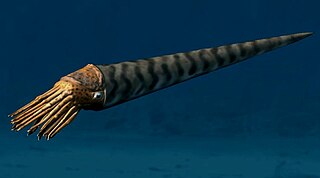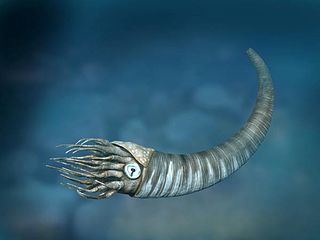
The siphuncle is a strand of tissue passing longitudinally through the shell of a cephalopod mollusk. Only cephalopods with chambered shells have siphuncles, such as the extinct ammonites and belemnites, and the living nautiluses, cuttlefish, and Spirula. In the case of the cuttlefish, the siphuncle is indistinct and connects all the small chambers of that animal's highly modified shell; in the other cephalopods it is thread-like and passes through small openings in the septa (walls) dividing the camerae (chambers). Some older studies have used the term siphon for the siphuncle, though this naming convention is uncommon in modern studies to prevent confusion with a mollusc organ of the same name.

Nautiloids are a group of marine cephalopods (Mollusca) which originated in the Late Cambrian and are represented today by the living Nautilus and Allonautilus. Fossil nautiloids are diverse and species rich, with over 2,500 recorded species. They flourished during the early Paleozoic era, when they constituted the main predatory animals. Early in their evolution, nautiloids developed an extraordinary diversity of shell shapes, including coiled morphologies and giant straight-shelled forms (orthocones). No orthoconic and only a handful of coiled species, the nautiluses, survive to the present day.

Endocerida is an extinct nautiloid order, a group of cephalopods from the Lower Paleozoic with cone-like deposits in their siphuncle. Endocerida was a diverse group of cephalopods that lived from the Early Ordovician possibly to the Late Silurian. Their shells were variable in form. Some were straight (orthoconic), others curved (cyrtoconic); some were long (longiconic), others short (breviconic). Some long-shelled forms like Endoceras attained shell lengths close to 6 metres (20 ft). The related Cameroceras is anecdotally reported to have reached lengths approaching 9 metres (30 ft), but these claims are problematic. The overwhelming majority of endocerids and nautiloids in general are much smaller, usually less than a meter long when fully grown.

Orthocerida, also known as the Michelinocerida, is an order of extinct orthoceratoid cephalopods that lived from the Early Ordovician possibly to the Late Triassic. A fossil found in the Caucasus suggests they may even have survived until the Early Cretaceous, and the Eocene fossil Antarcticeras is sometimes considered a descendant of the orthocerids although this is disputed. They were most common however from the Ordovician to the Devonian.

Neocephalopods are a group of cephalopod mollusks that include the coleoids and all extinct species that are more closely related to extant coleoids than to the nautilus. In cladistic terms, it is the total group of Coleoidea. In contrast, the palcephalopoda are defined as the sister group to the neocephalopoda.

Plectronocerida is a primitive order from which subsequent cephalopod orders are ultimately derived.
The Ellesmerocerida is an order of primitive cephalopods belonging to the subclass Nautiloidea with a widespread distribution that lived during the Late Cambrian and Ordovician.
Clarkoceras is a genus of breviconic ellesmerocerid cephalopods, one of only two genera known to have crossed from the Late Cambrian, Trempealeauan, into the Early Ordovician, Gasconadian. ; the other being Ectenolites.

Lituitida is an order of orthoceratoid cephalopods. They correspond to the family Lituitidae of the Treatise, reranked as an order and combined with other orthoceratoids. They are considered to be more closely related to the Orthocerida than to the Ascocerida or Pseudorthocerida which are also included.

The Ellesmeroceratidae constitute a family within the cephalopod order Ellesmerocerida. They lived from the Upper Cambrian to the Lower Ordovician. They are characterized by straight and endogastric shells, often laterally compressed, so the dorso-ventral dimension is slightly greater than the lateral, with close spaced sutures having shallow lateral lobes and a generally large tubular ventro-marginal siphuncle with concave segments and irregularly spaced diaphragms. Connecting rings are thick and layered, externally straight but thickening inwardly with the maximum near the middle of the segment so as to leave concave depressions on internal siphuncle molds. Septal necks are typically orthochoanitic but vary in length from almost absent (achoanitic) to reaching halfway to the previous septum (hemichoanitic) and may even slope inwardly (loxochoanitic).
Bactroceras is a genus of orthoceratoid cephalopods that lived during the early Middle Ordovician, from about 472—464 mya, existing for approximately 8 million years.

Orthoceratoidea is a major subclass of nautiloid cephalopods. Members of this subclass usually have orthoconic (straight) to slightly cyrtoconic (curved) shells, and central to subcentral siphuncles which may bear internal deposits. Orthoceratoids are also characterized by dorsomyarian muscle scars, extensive cameral deposits, and calciosiphonate connecting rings with a porous and calcitic inner layer.
The cephalopods have a long geological history, with the first nautiloids found in late Cambrian strata.
Jiagouceras is a genus of early primitive cephalopods from the Upper Cambrian of China, assigned to the Plectronoceratidae. The shell is small, nearly straight with a slight endogastric curvature and compressed cross section. The siphuncle is close to the ventral margin, with segments expanded into the chambers.
Murrayoceras is a nautilid cephalopod included in the orthocerid family Baltoceratidae, widespread in the Middle Ordovician of North America, characterized by a depressed orthoconic shell with a subtriangular cross section and flattened venter and a proportionally large ventral siphuncle, 0.15 to 0.3 the dorso-ventral shell diameter. Septa are close spaced with sutures forming broad lobes on the upper flanks and ventral surface.
Cyrtocerinida is an order of Ordovician nautiloid cephalopods. The order includes the families Cyrtocerinidae and Eothinoceratidae, as well as the genera Bathmoceras and Rummoceras.
Protactinocerida is a proposed order of Late Cambrian nautiloid cephalopods. Their fossils have only been found in the Late Cambrian of North China, a diversity pattern similar to other early cephalopod orders.
Yanhecerida is a small order of Late Cambrian nautiloid cephalopods. They were similar to the more diverse Plectronocerida and Ellesmerocerida, with short shells, closely spaced septa, and diaphragms (partitions) within the siphuncle. Their most distinctive trait is the conical shape of the diaphragms, similar to the endocones which characterize the later nautiloid order Endocerida. While some authors have argued that Yanhecerida should be lumped into Ellesmerocerida, a phylogenetic analysis has maintained that Yanhecerida is a valid clade of early cephalopods closely related to a paraphyletic Ellesmerocerida.

Multiceratoidea is a major subclass or superorder of Paleozoic nautiloid cephalopods. Members of this group can be characterized by nautilosiphonate connecting rings, with an organic inner layer and outer layer of calcitic spherules and blades, similar to the modern nautilus. The earliest-diverging multiceratoids have oncomyarian muscle scars, though several orders trend towards a ventromyarian condition. Multiceratoid shells are generally short and curled, with a relatively small aperture (opening). Cameral deposits are never found among the multiceratoids, though several orders are known to bear endosiphuncular deposits within their siphuncles.
Riocerida, originally named as Rioceratida, is an extinct order of Ordovician nautiloid cephalopods. They were the earliest-diverging members of the major group Orthoceratoidea, with which they share dorsomyarian muscle scars. However, they also possess several plesiomorphic ("primitive") traits which are absent in other orthoceratoids: Cameral and endosiphuncular deposits are absent, and the siphuncle has a marginal position along the lower edge of the shell. The conch shape is slender, usually orthoconic (straight) or weakly cyrtoconic. The monophyly of Riocerida as a unique group is plausible but difficult to confirm, and they may instead be a paraphyletic grade or polyphyletic assemblage ancestral to all later orthoceratoids.









